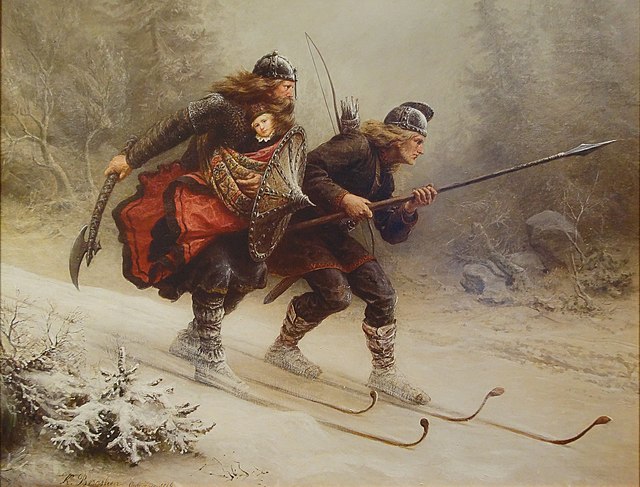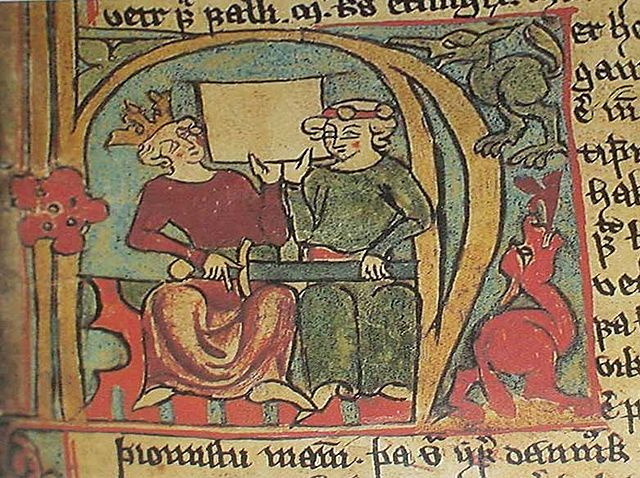Ski season is rapidly coming to an end in much of North America. For those who find going cold turkey into non-ski season difficult to manage, a Nordic cinematic experience might be just the salve to heal the wounds of snow’s departure. The film up for review in this episode of FasterSkier at the Movies is The Last King. It’s a 2016 Norwegian film based on of the tale of the Birkebeiner rescue of Prince Haakon Haakonsson. The movie is in Norwegian with subtitles.

If you’ve ever skied any Birkie race, heard about the Birkie, or been around cross-country skiing for more than a few days, you probably know the story. But here’s a brief recap: infant Prince gets rescued from the clutches of bad guys and transported across the Norwegian countryside by warriors wearing animal skins for clothing, birch bark for leggings, and skiing on very, very long skis, while using only one pole which doubles as a weapon. The boy lives to become King: happiness ensues, ski races are born.
That’s the story told by The Last King. It’s a cinematic depiction of the Birkebeiner rescue.

The skiing and snow scenes are beautifully done. The stunt skiers make skiing on very long boards look effortless and elegant. However, some liberties are taken such as when Birkebeiner warriors make quick escapes by putting on their skis faster than you can kick the snow out of a NNN binding. The stunt skiers really earned their paychecks and showed skill on equipment which you will not see elsewhere. The ski scenes alone are worth the price of admission.
Also deserving of praise is the photography, which is sweeping and elegant. The action sequences are also nicely choreographed. The flight and chase scenes through the winter landscape flow nicely, and you never get the feeling of special effects taking over the show. That’s part of the beauty of this movie. Though there were undoubtedly some post-production sleights of hand, everything appears realistic and believable, especially the skiing.

The Last King is a bit of a mashup of Braveheart meets Gladiator on skis. So, there’s lots of violence. This is, after all, civil war in the 13th century. If you’re turned off by axe and broadsword fighting, this won’t be for you. But the violence is nothing worse than your kids probably see on a run-of-the-mill video game. There are some brief sex scenes as well. This combination earns the movie its R rating.
The only thing missing is—the story. Lots of movies have successfully and engagingly told stories to which we already knew the ending: think Titanic or Apollo 13. The big difference between The Last King and those movies is that those movies had characters you were interested in and could care about. The Last King doesn’t take the time to develop its characters and relies on the fact that you know the story. The bad guys are very bad. The good guys are very good. The film provides no explanation as to why.
One reason Gladiator was such a compelling movie was that it took time to develop its characters and give viewers insight into them. Commodus wasn’t likeable; you were never rooting for him, but he was compelling. The Last King makes no such development effort, and that’s the problem. Perhaps every Norwegian school child knows the details of the history surrounding this event, and it isn’t necessary to tell more for them to make the story resonate. But for North American audiences, the lack of character development and narrative details are a gaping void.

Gisle—the leader of the revolt against King Haakon—seems like a bad fellow, but I have absolutely no understanding of his motivation or reasons for preferring the Bagler faction, though religion seems to have something to do with it. The Bagler faction was something I was not familiar with prior to seeing the movie, and I suspect most non-Norwegian viewers will not be as well. Some level of explanation would have been useful plot development. But there’s absolutely no backstory about Gisle’s relationship to the King or why he wants him dead. It’s actually hard to develop too much dislike for the villain other than his obvious sexual exploitation of women and poor treatment of his brother. If you remember Braveheart, it was really easy to dislike the King (Longshanks) because time was devoted to detailing his loathsome character.

A treasonous Birkebeiner character also gets short shrift. But perhaps the most annoying lapse was the treatment of Queen Margret: she appears, agrees to treason, and disappears with only the vaguest reasons, and then never an explanation of what became of her. The constant narrative voids nag at you the entire way, which makes a second viewing worthwhile. The movie markedly improves once you’ve pieced together the storyline from a first viewing. If you have the time, give it a second go.
With a run time of 1:39 there was certainly opportunity for a little character development, and in this case, a little would have gone a long way.
The Birkebeiners are just as you would expect: on the stoic side, great skiers, and highly resistant to arrows.
The movie has a beautiful soundtrack (performed by the Bratislava Symphony orchestra) to accompany the fine cinematography. Seldom will you see film credits listing the hurdy-gurdy, but this movie has that as well. Filmed on location in Lillehammer, Norway, the sense of immersion into the Scandinavian landscape is thorough.
For any ski fan who has raced, watched, or discussed the Birkie races, The Last King will be an entertaining ski-centric way to spend an hour and a half. Even for non-skiers, the movie offers enough solid action and alluring visuals to be enjoyable.
The Last King is available on Amazon Prime and other streaming services.



